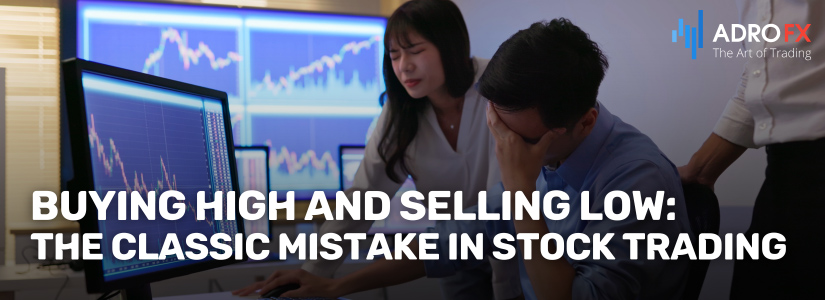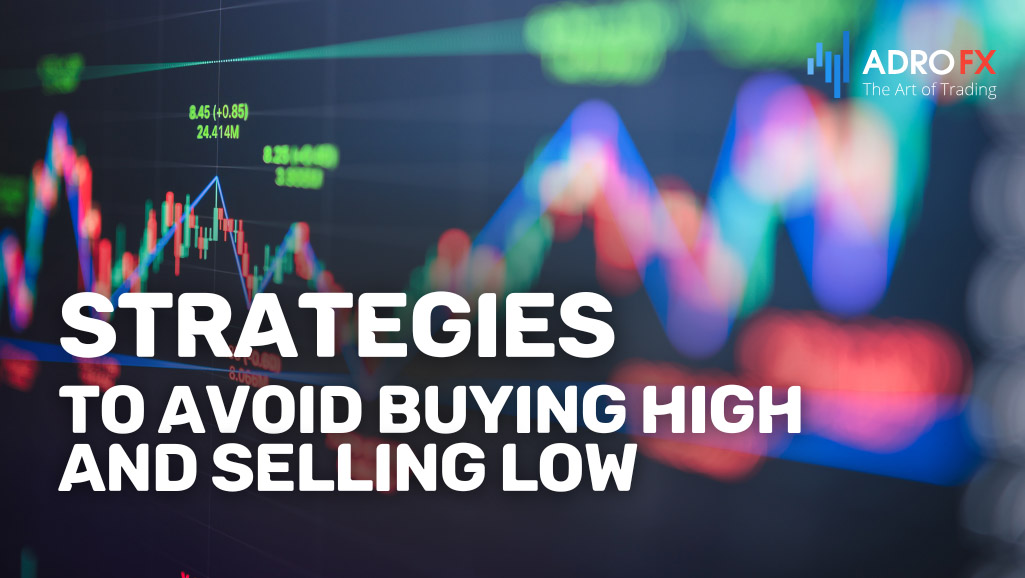Buying High and Selling Low: The Classic Mistake in Stock Trading

Stock trading is a popular way to grow wealth, but it requires a solid understanding of market dynamics and disciplined decision-making. At its core, stock trading involves buying and selling shares with the goal of making a profit. While the concept is simple, executing trades effectively can be challenging, especially for beginners. One of the most common and costly mistakes in stock trading is buying high and selling low. This error happens when traders purchase stocks at peak prices, driven by emotions like greed or fear of missing out (FOMO), only to sell them later at a lower price, often out of panic.
Understanding and avoiding the mistake of buying high and selling low is crucial for long-term success in stock trading. This classic error can significantly erode your profits and derail your trading strategy. By recognizing the psychological and emotional triggers that lead to this mistake, traders can make more informed decisions and develop strategies to minimize losses. In this article, we will explore the reasons behind this common trading error and provide insights on how to avoid falling into this trap.
Understanding the Classic Mistake
The phrase "buying high and selling low" refers to the unfortunate situation where traders purchase stocks at elevated prices and then sell them at a lower price, resulting in a loss. This goes against the fundamental principle of successful trading, which is to buy low and sell high. Despite this basic rule, many traders find themselves caught in the cycle of buying high and selling low due to various factors.
For example, imagine a trader who buys shares of a popular tech company after a strong rally, believing that prices will continue to rise. However, when the market corrects, and the stock price drops, the trader panics and sells at a loss, fearing further decline. This scenario is a classic case of buying high and selling low, where emotional decision-making overrides rational analysis.
Psychological and Emotional Factors
The mistake of buying high and selling low is often driven by psychological and emotional factors. Two key emotions that play a significant role in this mistake are fear and greed.
- Greed
Greed can cause traders to chase after stocks that have already experienced significant price increases, hoping to capitalize on continued gains. This often leads to buying at inflated prices, just before the stock price peaks and starts to decline.
- Fear
On the flip side, fear can prompt traders to sell their stocks prematurely during market downturns. When prices begin to drop, panic sets in, and traders rush to sell to avoid further losses, even if it means selling at a lower price than they originally paid.
Cognitive biases like loss aversion and FOMO further contribute to this mistake. Loss aversion is the tendency to fear losses more than value gains, leading traders to sell in a downturn to avoid potential losses. FOMO, or the fear of missing out, can drive traders to buy stocks that are surging in price, fearing that they’ll miss out on potential profits. Both biases can cloud judgment and lead to impulsive decisions, ultimately resulting in the classic mistake of buying high and selling low.
By recognizing these psychological triggers and biases, traders can take steps to mitigate their influence and make more rational, informed trading decisions.
Also read: What is FOMO in Trading and How to Avoid It
Why It’s a Problem
The mistake of buying high and selling low is more than just a momentary lapse in judgment; it has far-reaching consequences that can undermine a trader’s overall performance. When repeated, this error can drain your trading account, reduce your ability to recover losses, and ultimately derail your long-term financial goals. To fully grasp the gravity of this mistake, it’s essential to understand how it impacts profitability and why poor timing and market conditions often exacerbate the problem.

Impact on Trading Performance
The mistake of buying high and selling low can have a devastating impact on a trader's profitability. This pattern of trading results in consistent losses, as traders enter positions at inflated prices and exit at lower levels, locking in negative returns. Over time, even a few instances of buying high and selling low can erode capital, making it harder to recover and generate profits.
For example, during the dot-com bubble in the late 1990s, many traders bought technology stocks at sky-high prices, driven by the hype and fear of missing out on potential gains. When the bubble burst, those who bought at the peak were forced to sell at a fraction of the price, leading to significant financial losses. This real-life example highlights how the combination of market euphoria and panic can lead to disastrous trading outcomes.
The key issue with buying high and selling low is that it goes against the fundamental principle of successful trading - buying low and selling high. By consistently executing trades in the wrong direction, traders undermine their ability to build wealth and achieve their financial goals. Moreover, this mistake can create a negative feedback loop, where repeated losses lead to further emotional decision-making, compounding the problem.
Market Conditions and Timing
Market conditions and timing play a critical role in exacerbating the mistake of buying high and selling low. During periods of high market volatility, prices can swing dramatically, leading traders to make impulsive decisions. For instance, in a highly volatile market, a stock may experience rapid price increases, luring traders into buying at elevated levels. However, when the market corrects, these same traders may panic and sell, locking in losses.
Poor timing is another factor that contributes to this mistake. Traders often buy stocks during a bull market when prices are already high, driven by the belief that the upward trend will continue indefinitely. However, when the market inevitably corrects or reverses, they find themselves holding overvalued assets. Similarly, during a bear market or a market crash, fear can drive traders to sell at the worst possible time, just before the market rebounds.
Market trends also influence trading decisions. In a strong uptrend, traders may be tempted to buy at any price, assuming that the trend will continue. Conversely, in a downtrend, fear of further declines can lead to premature selling. Understanding the broader market context and carefully timing entries and exits is crucial to avoiding the pitfall of buying high and selling low.
Identifying the Mistake in Practice
Recognizing when you're falling into the trap of buying high and selling low is the first step toward breaking the cycle. Many traders aren't even aware that they are making this classic mistake until it’s too late. By examining common scenarios where this error occurs and identifying the warning signs, you can develop strategies to avoid it and improve your overall trading discipline.
Common Scenarios and Triggers
Several common scenarios and triggers can lead traders to buy high and sell low. One typical situation is during a bull market, where rising prices and positive sentiment create a sense of urgency among traders. Driven by FOMO, they may buy stocks at inflated prices, only to see the market correct shortly after. This often happens after major news events, such as earnings reports or product launches, where the initial excitement pushes prices up before reality sets in.
Another common scenario is during a market bubble, where assets are driven to unsustainable levels by speculative trading. Traders who buy near the peak of a bubble are particularly vulnerable to selling in a panic when the bubble bursts and prices plummet. The cryptocurrency boom of 2017, where Bitcoin reached all-time highs before crashing, is a notable example of this phenomenon.
Warning Signs
Recognizing the warning signs that you might be buying high and selling low is essential to prevent this mistake. One key indicator is overbought and oversold conditions, which can be identified using technical analysis tools like the Relative Strength Index (RSI). When the RSI shows that a stock is overbought, it suggests that the price may have risen too quickly and could be due for a correction. Buying in such conditions increases the risk of purchasing at the peak.
Similarly, selling when a stock is oversold, indicated by a low RSI, may mean exiting at a low point when the price is more likely to rebound. Another warning sign is excessive market hype or fear. If you find yourself making trading decisions based on emotional reactions to news or market sentiment, it may be a sign that you're about to fall into the buy-high, sell-low trap.
Charts and data can also help illustrate these warning signs. For example, a price chart showing a parabolic rise followed by a sharp decline is a classic pattern where traders are likely to buy high and sell low. By analyzing past price movements and understanding technical indicators, traders can develop a more disciplined approach and avoid this common mistake.
Also read: CFD Trading Psychology: Mastering Emotions for Better Results

Strategies to Avoid Buying High and Selling Low
Avoiding the costly mistake of buying high and selling low requires a combination of discipline, strategy, and the right tools. By developing a solid trading plan, leveraging technical analysis, and implementing risk management techniques, traders can make more informed decisions and protect their capital. Below, we'll explore several strategies that can help you steer clear of this common pitfall.
Developing a Trading Plan
A well-structured trading plan is essential to avoid impulsive decisions and prevent the mistake of buying high and selling low. A trading plan outlines your trading goals, risk tolerance, and specific strategies for entering and exiting trades. By sticking to a predefined plan, you can maintain discipline and avoid making emotional decisions based on market fluctuations.
Key elements to include in your trading plan to avoid this mistake are clear entry and exit criteria, risk management rules, and a commitment to following the plan even in volatile markets. For example, your plan might specify that you only buy stocks when they are within a certain price range or when technical indicators signal a buying opportunity. Having these rules in place helps you avoid chasing after high prices or selling out of fear during a downturn.
Using Technical Analysis
Technical analysis is a powerful tool that can guide your trading decisions and help you avoid buying high and selling low. By using technical indicators like Moving averages (MAs) and the Relative Strength Index (RSI), you can better time your entries and exits, reducing the likelihood of making emotional trades.
For instance, MAs can help you identify trends and determine when a stock is overbought or oversold, while RSI indicates momentum and potential reversals. By relying on these tools, you can make more data-driven decisions, ensuring that you're not buying at inflated prices or selling prematurely. Using technical analysis also allows you to set more realistic price targets, helping you stay patient and avoid the temptation to chase after price movements.
Setting Stop Loss and Take Profit Levels
Stop Loss and Take Profit levels are essential components of a successful trading strategy. A Stop Loss order automatically sells your stock if it drops to a certain price, limiting your losses and preventing further decline. A Take Profit order, on the other hand, automatically sells your stock when it reaches a certain profit level, ensuring that you lock in gains before the market reverses.
To set these levels effectively, consider factors such as the stock’s volatility, support and resistance levels, and your risk tolerance. For example, if you buy a stock at $100, you might set a Stop Loss at $90 to cap potential losses and a Take Profit at $120 to secure gains. These strategies not only protect your capital but also help you avoid the emotional rollercoaster that often leads to buying high and selling low.
Psychological and Behavioral Adjustments
Even with a solid trading strategy in place, psychological and behavioral factors can still lead to poor decisions. Managing emotions and improving decision-making are crucial steps in avoiding the classic mistake of buying high and selling low. By making small adjustments to your mindset and trading habits, you can maintain discipline and make more rational choices.
Managing Emotions
Controlling your emotions during trading is essential for long-term success. Fear, greed, and anxiety can cloud judgment, leading to impulsive decisions that often result in buying high and selling low. To manage these emotions, consider implementing techniques such as journaling and mindfulness. Journaling your trades allows you to reflect on your decisions, helping you recognize emotional patterns and avoid repeating mistakes. Mindfulness practices, such as deep breathing or meditation, can help you stay calm and focused, reducing the likelihood of panic-driven trades.
Staying disciplined is another key to managing emotions. Set strict rules for your trading activities, such as limiting the number of trades per day or taking breaks after a loss. This structure can prevent you from making rash decisions that could negatively impact your performance.
Improving Decision-Making
Objective decision-making is critical in trading. Instead of relying on gut feelings or market hype, base your decisions on thorough analysis and well-defined criteria. One strategy to improve decision-making is to review your past trades regularly. By analyzing what worked and what didn’t, you can identify patterns and adjust your strategy accordingly.
Another approach is to create a checklist of factors to consider before entering or exiting a trade. This might include reviewing technical indicators, assessing market conditions, and considering your risk management rules. By following a systematic process, you can reduce the influence of emotions and make more rational, data-driven decisions.
Improving your decision-making process and managing your emotions effectively can make all the difference in avoiding the classic mistake of buying high and selling low, ultimately leading to a more successful trading journey.
Conclusion
The mistake of buying high and selling low is a common yet costly error in stock trading, driven by emotions and poor timing. Understanding this classic mistake and its impact on your trading performance is crucial for long-term success. By recognizing the psychological factors that lead to this error and implementing strategies to avoid it - such as developing a solid trading plan, using technical analysis, and setting appropriate Stop Loss and Take Profit levels - you can significantly improve your trading outcomes.
To recap, avoiding the mistake of buying high and selling low is essential for preserving your capital and enhancing your profitability. A structured trading plan keeps you disciplined, while technical analysis provides the tools needed for informed decision-making. Additionally, managing your emotions and improving your decision-making process are vital to overcoming the cognitive biases that often lead to this mistake.
Now is the time to put these strategies into practice. Start by refining your trading plan and incorporating the tools and techniques discussed. If you’re looking to deepen your trading knowledge, consider exploring advanced trading articles, tools, or courses that can further enhance your skills. By continuously learning and adapting, you can avoid the pitfalls of emotional trading and achieve greater success in the markets.
About AdroFx
Established in 2018, AdroFx is known for its high technology and its ability to deliver high-quality brokerage services in more than 200 countries around the world. AdroFx makes every effort to keep its customers satisfied and to meet all the trading needs of any trader. With the five types of trading accounts, we have all it takes to fit any traders` needs and styles. The company provides access to 115+ trading instruments, including currencies, metals, stocks, and cryptocurrencies, which make it possible to make the most out of trading on the financial markets. Considering all the above, AdroFx is the perfect variant for anyone who doesn't settle for less than the best.










